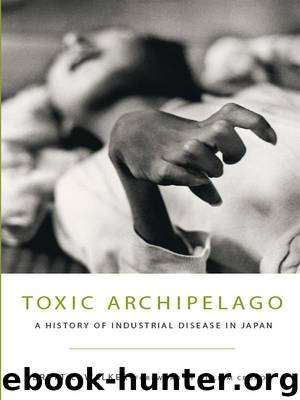0295991380 (N) by Brett Walker

Author:Brett Walker
Language: eng
Format: mobi
ISBN: 9780295803012
Publisher: University of Washington Press
Published: 0101-01-01T00:00:00+00:00
PART II
We now turn our attention to the history of the quest for phosphate and nitrogen, both within Japan and on a global scale. This analysis will connect the “nitrogen problem,” as it was labeled in the early twentieth century, to Japan's agricultural needs, European and Japanese imperialism, the ecological footprint of Japan's urban environments, the birth of atmospheric nitrogen fixation technologies, the advent of the plastics industry in Japan, and, ultimately, methylmercury poisoning. Atmospheric nitrogen fixation such as that practiced at the Chisso factory utilized mercury as a catalyst, which was then discarded into the marine environment, ultimately finding its way, as we traced in part I of this chapter, to the pinnacle of the global food ladder, the human fetus. Part II of this chapter explores how methylmercury was produced and how the relationships among women's bodies, fetuses, and the environment were interpreted by Japanese doctors and other health officials. To do this, we will explore elements of preindustrial Japanese medicine, because it was an earlier generation of pluralistic medical practitioners who, more than their modern compartmentalizing counterparts, viewed the body as inextricably embedded in the natural environment. In some respects, the journey of methylmercury to the human fetus only reified a human-nature connection understood for centuries in Japan.
But the first two questions we must tackle are these: How did the Chisso factory arrive at the small, largely impoverished fishing community of Minamata? What were the historical circumstances surrounding its construction and the technological developments that poisoned the surrounding marine environment? As it turns out, even though Minamata disease was the product of local ecological circumstances, the forces that brought Chisso to Minamata were global in scale, and require some discussion.
Phosphate, Nitrogen, and Japan's Industrial Metabolism
Engineer Noguchi Jun (1873–1944) founded Nihon Chisso Hiryō Company (the chemical company referred to as Chisso throughout this chapter) in 1908, during a global push for scientific advancements in electrochemistry, principally for the production of nitrogenous fertilizers and other products. Until Noguchi arrived on the scene, Japan's chemical industry remained confined to the production of sulfuric acid and soda; the Meiji government used the former to print paper money, and industry used the latter to bleach textiles. By the late nineteenth century, the chemical industry had expanded to include the production of matches, which became Japan's leading chemical-industry export. By the early twentieth century, the most powerful chemical firms in Japan sought to develop new kinds of fertilizers to assist with Japan's rapid industrialization. As we learned in chapter 2, Japan's promotion of industrial agriculture after the Meiji Restoration depended on liberal applications of chemical fertilizer.
Download
This site does not store any files on its server. We only index and link to content provided by other sites. Please contact the content providers to delete copyright contents if any and email us, we'll remove relevant links or contents immediately.
| Africa | Americas |
| Arctic & Antarctica | Asia |
| Australia & Oceania | Europe |
| Middle East | Russia |
| United States | World |
| Ancient Civilizations | Military |
| Historical Study & Educational Resources |
The Sympathizer by Viet Thanh Nguyen(4091)
The Rape of Nanking by Iris Chang(4020)
World without end by Ken Follett(3339)
Ants Among Elephants by Sujatha Gidla(3278)
Blood and Sand by Alex Von Tunzelmann(3055)
Japanese Design by Patricia J. Graham(2997)
City of Djinns: a year in Delhi by William Dalrymple(2430)
Foreign Devils on the Silk Road: The Search for the Lost Treasures of Central Asia by Peter Hopkirk(2385)
Inglorious Empire by Shashi Tharoor(2345)
The Queen of Nothing by Holly Black(2308)
In Order to Live: A North Korean Girl's Journey to Freedom by Yeonmi Park(2301)
India's Ancient Past by R.S. Sharma(2293)
Tokyo by Rob Goss(2286)
India's biggest cover-up by Dhar Anuj(2241)
Tokyo Geek's Guide: Manga, Anime, Gaming, Cosplay, Toys, Idols & More - The Ultimate Guide to Japan's Otaku Culture by Simone Gianni(2234)
The Great Game: On Secret Service in High Asia by Peter Hopkirk(2227)
Goodbye Madame Butterfly(2161)
Batik by Rudolf Smend(2006)
Living Silence in Burma by Christina Fink(1977)
